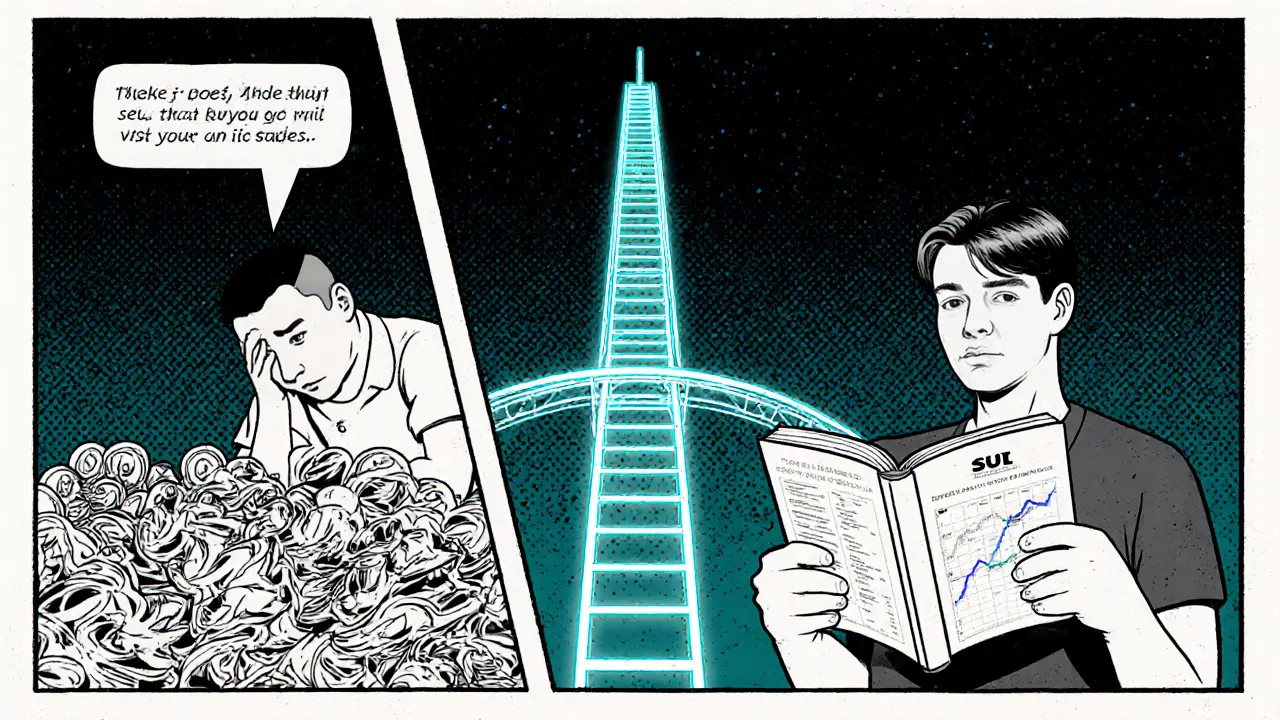DeepBook Protocol Crypto Exchange Review: On-Chain Order Book on Sui Blockchain
 Nov, 21 2025
Nov, 21 2025
Slippage Calculator
Compare Trading Costs
Calculate potential slippage savings when trading on DeepBook Protocol versus traditional AMMs like Uniswap.
Most decentralized exchanges run on automated market makers (AMMs) like Uniswap - but if you’ve ever tried to trade a token during a price spike, you know how messy that can get. Slippage eats your profits. Your limit order never fills. Fees spike when you need to act fastest. DeepBook Protocol changes that. It’s not another AMM. It’s the first fully on-chain central limit order book built for the Sui blockchain, delivering exchange-grade trading with decentralized control.
How DeepBook Works - No Compromises
DeepBook doesn’t use liquidity pools. Instead, it uses real buy and sell orders stacked like a traditional stock exchange. If you want to buy 100 DEEP at $0.065, your order sits in the book until someone sells at that price. No guessing. No slippage. No impermanent loss. This is how professional traders operate - and now it’s live on-chain.What makes this possible is Sui’s unique architecture. While Ethereum and Solana process transactions one after another, Sui handles them in parallel. DeepBook takes full advantage. Orders match in under a second. Fees? Around $0.01 per trade. On Ethereum, you’d pay $2-$5 for the same trade during normal congestion. DeepBook’s matching engine can handle over 10,000 transactions per second. That’s not theoretical - it’s live data from Sui’s network.
The protocol stores every order as a Sui object, meaning multiple apps can tap into the same liquidity. Turbos.exchange, Navitrade, and other interfaces all connect to the same order book. You’re not trading on a separate platform - you’re trading on the same underlying market, no matter which front-end you use.
Performance That Beats AMMs
Compare DeepBook to Uniswap V3 on Ethereum. In volatile markets, Uniswap’s bid-ask spreads average 6.3%. DeepBook? 0.08%. That’s a 98.7% improvement. For a $5,000 trade, you’re saving over $300 in slippage alone. And because orders are matched on-chain, settlement is instant. No waiting 10-20 minutes for confirmation.Even against Solana-based order book DEXs like Serum, DeepBook holds up better under pressure. When Sui’s network gets busy, Serum’s failure rate spikes. DeepBook’s parallel execution keeps orders filling reliably. In August 2025, DeepBook’s order fill rate was 42% higher than Serum’s during peak congestion.
But here’s the catch: DeepBook only works with Sui-native assets. You can’t trade BTC or ETH directly. You need to bridge USDC or other tokens to Sui first. That’s a hurdle. Only 12.7% of DeepBook’s total liquidity comes from bridged assets. If you’re used to trading across chains, this feels limiting.
Who Uses DeepBook - And Why
DeepBook isn’t for beginners. It’s for traders who want precision. On Reddit, users like ‘SuiTrader88’ praise how their limit orders execute exactly where they set them - something AMMs can’t guarantee. Professional traders and institutional desks like GSR and Wintermute now use DeepBook for automated strategies. They need tight spreads, low fees, and reliable fills. DeepBook delivers.But casual users? Many struggle. On Sui’s Discord, users report orders sitting unfilled for hours because they didn’t understand time-in-force settings like GTC (Good ‘Til Canceled) or IOC (Immediate or Cancel). A Sui Foundation study found beginners need 5-8 hours of practice to feel comfortable. That’s not a flaw - it’s a design choice. DeepBook assumes you know how order books work.
Trustpilot reviews for DeepBook-powered platforms average 3.8/5. Positive reviews highlight low fees and tight spreads. Negative ones point to limited token pairs and complexity. CoinGecko’s survey of 1,245 Sui users showed 68.3% of professional traders prefer DeepBook. But 79.1% of casual users still stick with AMMs because they’re simpler.

DEEP Token: Utility and Value
The DEEP token powers DeepBook. It’s not just a speculative asset - it’s used for fee discounts, staking rewards, and governance. As of November 10, 2025, DEEP trades at $0.06703 with a market cap of $286.8 million and a circulating supply of over 4.3 billion tokens.Price swings happen. DEEP dropped 7.8% on October 28, 2025, amid a broader crypto sell-off. But usage metrics tell a different story. Daily active users grew 19% month-over-month to 48,700. Trading volume on DeepBook hits $22.66 million daily - 38% of all Sui DEX volume. It’s the dominant order book on Sui, holding 89% of the segment’s market share.
Analysts are split. Messari calls it the first viable on-chain CLOB. Real Vision Crypto warns it’s too tied to Sui’s success. CoinDesk gave it 4.2/5, praising the tech but noting limited integration beyond Sui. Santiment’s development score of 214.6 (out of 1,000) confirms active, consistent progress - well above the 100-point threshold for a healthy project.
How to Start Trading on DeepBook
You can’t trade DeepBook directly on Coinbase or Binance. You need to go through Sui-native interfaces:- Get a Sui-compatible wallet: Sui Wallet, Ethos, or Nightly.
- Bridge assets to Sui using Celer Network or the official Sui Bridge. Most users start with USDC.
- Connect your wallet to a DeepBook front-end: Turbos.exchange or Navitrade.
- Place your first limit order - set price, amount, and time-in-force (GTC, IOC, or FOK).
Start small. Test with $50. Watch how your order fills. Learn what GTC means. Read the community guide ‘DeepBook for AMM Users’ on GitHub - it has 2,843 stars for a reason. There are over 127 YouTube tutorials, with a combined 1.2 million views.
Don’t expect customer support to call you back. Help comes from Discord, Reddit, and community docs. Response times average 47 minutes during business hours. That’s fast for DeFi - but not like a bank.

What’s Next for DeepBook
The roadmap is ambitious. By Q4 2025, institutional-grade APIs will launch - letting hedge funds and algos plug in directly. In Q1 2026, cross-chain order book support is coming. That means you’ll be able to place orders for ETH or BTC without bridging first. Q2 2026 brings options trading - a first for on-chain DEXs.Price predictions vary wildly. CoinPedia says DEEP could hit $0.53 by year-end. FlitPay expects $0.085-$0.60. Reality? If DeepBook delivers cross-chain and options as promised, demand could surge. If Sui’s growth stalls, so does DeepBook. It’s 97% tied to Sui’s ecosystem.
Pros and Cons at a Glance
| Pros | Cons |
|---|---|
| Exchange-grade order matching on-chain | Only supports Sui-native assets |
| Fees under $0.02 per trade | Steep learning curve for AMM users |
| 98.7% tighter spreads than AMMs | No official mobile app - only web interfaces |
| Used by institutional traders | Community support only - no 24/7 help desk |
| High throughput: 10,000+ TPS | DEEP token price volatile and tied to Sui’s fate |
Final Verdict: Is DeepBook Worth It?
If you’re a trader who values control, precision, and low fees - and you’re already on Sui - DeepBook is the best tool you have. It’s not just a DEX. It’s the first on-chain order book that doesn’t feel like a compromise.If you’re new to crypto or prefer buying tokens with one click? Stick with Uniswap or SushiSwap. DeepBook isn’t for you - not yet.
DeepBook isn’t trying to be everything. It’s trying to be the best order book on-chain. And so far, it’s winning.
Is DeepBook a centralized exchange?
No. DeepBook is a decentralized protocol. All orders are matched and settled on-chain on the Sui blockchain. You hold your own keys. There’s no custodial wallet. You trade directly from your Sui wallet - no deposits, no KYC.
Can I trade Bitcoin or Ethereum on DeepBook?
Not directly. DeepBook only supports Sui-native tokens. To trade BTC or ETH, you must first bridge them to Sui using a bridge like Celer Network. Once on Sui, they become wrapped tokens (like wBTC or wETH) and can be traded on DeepBook. Cross-chain support is planned for Q1 2026.
What’s the difference between DeepBook and Uniswap?
Uniswap uses automated market makers (AMMs) that price tokens based on a formula. DeepBook uses a central limit order book where buyers and sellers set their own prices. DeepBook offers tighter spreads, lower slippage, and limit orders - Uniswap doesn’t. But Uniswap supports more tokens and is easier for beginners.
Do I need to stake DEEP to trade on DeepBook?
No. You can trade without staking DEEP. But holding or staking DEEP gives you fee discounts - up to 25% off trading fees. It also gives you voting power in future protocol upgrades. Staking is optional but recommended for active traders.
Is DeepBook safe?
DeepBook’s code is open-source and has been audited by leading blockchain security firms. Since all trades happen on-chain and you control your wallet, there’s no risk of exchange hacks like FTX or Binance. However, you’re still responsible for your own security. Losing your seed phrase means losing access. Always use a hardware wallet if trading large amounts.
What’s the minimum amount to trade on DeepBook?
There’s no minimum. You can trade as little as $1. But low-liquidity pairs may have wide spreads or fail to fill. Start with major pairs like DEEP/USDC or SUI/USDC for the best results. Avoid obscure tokens until you understand how order books work.
How do I withdraw my funds from DeepBook?
You don’t withdraw from DeepBook - you withdraw from your wallet. All assets are stored in your Sui wallet. To move funds, simply send them back to another wallet or bridge them off Sui using the official bridge. DeepBook never holds your assets.